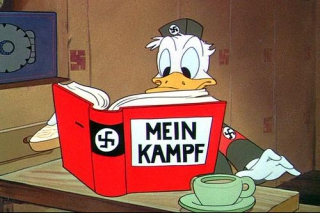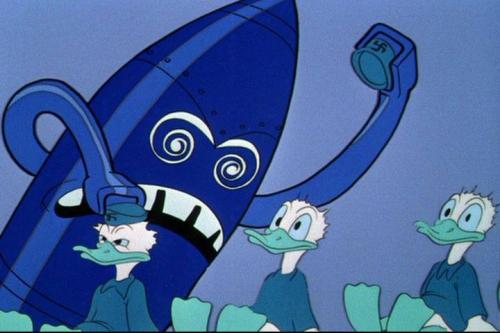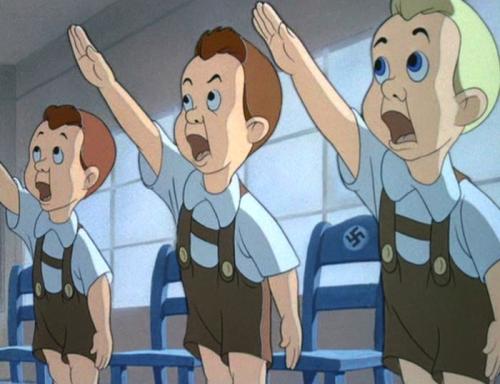In the German news magazine Spiegel, Sven Stillich published a short article on animated short movies that had been produced in the USA during the Second World War. Stylistics and motivation were quite different. The most known movie will be Disney’s “Der Fuehrer’s Face” from 1943, in which Donald Duck has a nightmare in “Nutzi Land”.
Would “Der Fuehrer’s Face” be some years older, one may enjoy the laughs about the many details more comfortably, e.g. the countless representations of swastikas, be it clouds, trees, hydrants, signposts or the wings of a windmill, as well as the Hitler cockoo clock or the “synchronised” rooster.1 In that time, however, the nightmare was harshest reality for millions of people. The racist portrayal of Japanese Tenno Hirohito produces not much fun today; but this discriptive normality (as in many other publications) is very telling. Not without irony is the end, when Donald Duck awakes from his nightmare, taking the shadow of a Statue of Liberty model for a Nazi salute. The film received an Oscar as “Best Short Subject, Cartoons” in 1943 and is well worth seeing, not just for the loony dream-in-dream sequence and the successful theme song with its biting text.
“Der Fuehrer’s Face” (Disney, 1943), YouTube
While this film is attacking the enemy with ridiculousness while indirectly showing for what it is worth to fight, “Education for Death: The Making of the Nazi” (published shortly thereafter and by Disney, too) takes another route: based on the same-named book by Gregor Ziemer, it describes the early indoctrination of children and not the least the environment of power and fear. Quite interestingly, some sequences are spoken in (real, not gibberish!) German without subtitles, adding to the atmosphere, assumably to support the authenticity.
“Education for Death” (Disney, 1943), YouTube
Other studios such as Hanna Barbara or MGM (Tex Avery worked for them, e.g.) published animated movies of varied quality; some should at least be named at this stage:
“Blitz Wolf” (MGM, 1942), YouTube
The important animator and director Tex Avery tells the story of the bad wolf and the three piglets with a twist – and of course as basis for an absurd spree of destruction. The gags included are not all working well, however.
“Commando Duck” (Disney, 1944), YouTube
Special Forces soldier Donald Duck is ordered to destroy a Japanese airfield which he finally manages due to his clumsiness. One of the better movies for its richness of ideas and its tempo. The quotes of Japanese soldiers are interesting, too:
First soldier: “All right, here he coming. Time to shooting now, I hope.” (training his rifle at Donald)
Second soldier: “No, no. No, wait, please. Japanese custom say always shooting a man in the back, please.”
First soldier: “Oh, thank you.”
“Daffy the Commando” (Warner Bros., 1943), YouTube
Daffy Duck from the competing studio Warner is a commando, too. This film centres on the pseudo-German of the Nazi eagles and the well-known stereotypes (officer with monocle, etc.). Climax is a surprisingly realistic Hitler who got an A with cream on top by Daffy’s wooden mallet.
“Donald gets drafted” (Disney, 1942), YouTube
The promises of recruitment posters seduce Donald Duck to enlist as soldier – but his inaptness prevent him from becoming a heart-throb.
“Private Pluto” (Disney, 1943), YouTube
Pluto the dog is ordered to trace saboteurs in an army camp, but is abused as nutcracker by some chipmunks instead in this unfunny movie.
“Scrap Happy Daffy” (Warner Bros., 1943), YouTube
This movie is educational, too: Americans should collect scrap metal – victory against the Nazis will follow track.
“The Ducktators” (Warner Bros., 1942), YouTube
The ugly ducks Hitler, Mussolini and Hirohito (whose have been lumped together in propaganda) take over a farm, until the peace dove has enough. Interestingly, Hirohito gets his first pounding by a Chinese turtle.
“The Spirit of ’43” (Disney, 1943), YouTube
Another educational film, in which Donald Duck is encouraging to pay taxes in time for not endangering the war effort: “Taxes to bury the Axis!”
To quote the already mentioned “Looney Tunes”: “That’s all folks!” – at least for today.
- Gleichschaltung (literally synchronisation) is a Nazi term for establishing a totalitarian regime over the individual. ↩





